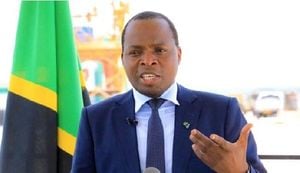On November 24, 2025, the Church of England found itself once again at the center of a painful reckoning. A tribunal in the Southwark diocese upheld a new complaint of child sexual abuse against David Tudor, a priest whose name has become synonymous with scandal and institutional failure. The decision marks the latest chapter in a decades-long saga that has exposed deep flaws in the Church’s handling of abuse allegations and left many asking how such a situation could have persisted for so long.
The tribunal’s findings are stark: David Tudor sexually abused a 15-year-old girl in Surrey during the 1980s, when he was serving as a priest. According to BBC reporting, the details of the case will be made public once the Church of England determines the appropriate penalty for Tudor. For now, the Church has acknowledged the survivor’s courage in coming forward, with the Bishop of Chelmsford, the Right Reverend Dr Guli Francis-Dehqani, stating, “she has shown great courage in coming forward to report David Tudor’s abuse, and I am profoundly sorry for the harm he has caused her and the other survivors of abuse he perpetrated.”
This new complaint is not the first time Tudor’s name has surfaced in connection with abuse. In October 2024, Tudor was struck off for life after admitting to sexually abusing two girls, including one under the age of 16, between 1982 and 1989. That admission came on the heels of a BBC investigation which uncovered significant failings in the Church’s response to Tudor’s behavior over the years. The investigation painted a picture of an institution that, time and again, failed to act decisively—or transparently—when confronted with allegations of abuse.
The roots of the scandal stretch back to 1988, when Tudor was convicted of indecently assaulting three girls. Yet, even then, justice proved elusive: the conviction was quashed on technical grounds, and Tudor was initially banned by the Church. But in a move that would later draw widespread condemnation, the Church allowed him to return to ministry after just five years.
What followed was a series of decisions that, in hindsight, seem almost unfathomable. According to BBC, former Archbishop of Canterbury Lord Carey resigned his service as a Church of England priest after it was revealed that he had personally advocated for Tudor. That advocacy paved the way for Tudor’s return to the Church, where he not only resumed his clerical duties but rose through the ranks, eventually becoming rector and area dean on Canvey Island, Essex.
The story doesn’t end there. In 2015, Tudor was appointed honorary canon of Chelmsford Cathedral. This promotion occurred during the tenure of Stephen Cottrell, now Archbishop of York, who was then bishop of Chelmsford. What’s particularly troubling is that this appointment was made despite an agreement that Tudor was not to be alone with children or enter schools in Essex, and even though it was known that he had paid compensation to a sexual abuse victim. The BBC’s investigation highlighted these facts, raising serious questions about the Church’s commitment to safeguarding and transparency.
As the scale of the failures became clear, calls for accountability grew louder. Archbishop Cottrell, for his part, refused to resign over his handling of the case. He insisted that he could only act when a fresh complaint was made against Tudor in 2019—a complaint which did, in fact, lead to Tudor’s suspension and eventual ban. Cottrell expressed regret over his handling of the situation, with a spokesperson stating, “he acknowledges this could have been handled differently” and adding that “all the risks around David Tudor were regularly reviewed” and that this was “the main focus.”
But for many survivors and advocates, these assurances ring hollow. The fact that Tudor was able to return to ministry after his conviction was quashed, and then rise to positions of authority despite prior allegations and compensation payments, is seen as emblematic of a broader culture of secrecy and protectionism within the Church. According to BBC, the Church’s actions—or inactions—over the years allowed Tudor to maintain a position of trust and authority, even as red flags continued to emerge.
In the wake of the latest tribunal decision, the Church of England has announced that the deadline for a safeguarding review into the Tudor case has been postponed to early 2026. The reason, it says, is “new police information.” This delay has frustrated some observers, who argue that the Church’s response to abuse allegations has consistently been too slow and too opaque. Nevertheless, Church officials maintain that the review is necessary to ensure all relevant information is considered and that future safeguarding measures are robust.
The Tudor case has also had significant repercussions for the Church’s leadership. Lord Carey’s resignation was a direct result of his support for Tudor, while Archbishop Cottrell’s refusal to step down has been met with both support and criticism. Some within the Church argue that Cottrell was hamstrung by institutional processes and could only act once new complaints were filed. Others contend that more proactive steps should have been taken, especially given Tudor’s history and the clear risks he posed.
For survivors of abuse and their advocates, the latest developments are a bittersweet vindication. On the one hand, the upholding of the new complaint is a long-overdue acknowledgment of the harm suffered by Tudor’s victims. On the other, it is a sobering reminder of how difficult it can be for survivors to obtain justice—and how institutions can fail to protect the vulnerable, even when the warning signs are clear.
The Church of England now faces a critical test. As it awaits the conclusion of the safeguarding review and the announcement of Tudor’s penalty, it must confront not only the failures of the past but the urgent need for reform. The eyes of the public, and especially survivors, will be watching closely to see whether the Church can finally live up to its moral responsibilities.
For now, the story of David Tudor stands as a cautionary tale—a reminder that trust, once broken, is difficult to restore, and that true accountability requires more than words of regret. It demands action, transparency, and an unwavering commitment to justice for those who have suffered in silence for far too long.




